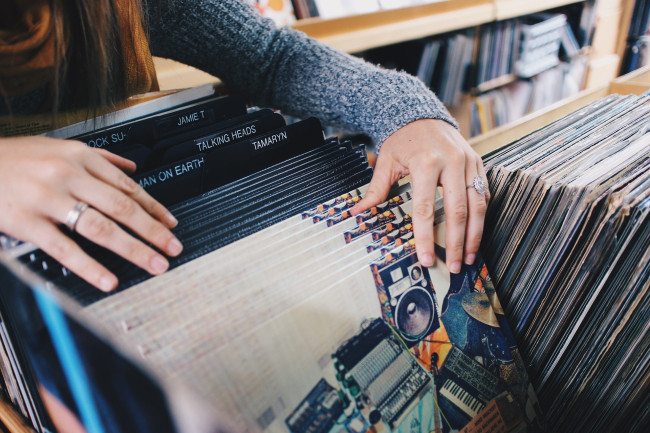The album at 70 years old: a format in decline?

The album – or at least, the 33rpm vinyl record that spawned the format – turns 70 years old this year. But it isn’t ageing gracefully. Even five years ago, Bob Lefsetz declared that “the album is dying in front of our very eyes” – and given how comprehensively streaming services are decimating record sales, that still seems a reasonable observation.
In 2017, U.K. revenues from subscription streaming platforms rose 41.9 percent to £577m, while physical formats dropped 3.4 percent and online downloading dropped 23.1 percent. Album sales – as hard copies and digital files – have halved since 2010.
Reports of the album’s death, however, may have been greatly exaggerated, or at least underestimated how prolonged a demise it could be. A host of media outlets are celebrating the album’s landmark birthday, the prestigious Mercury Album Prize just announced its nominees, and the Scottish Album of the Year Award did the same soon after. A cultural as much as a physical phenomenon, decades of influence have granted the album a presence in the public consciousness that goes far beyond finance.
A place in the history books
It was progress in plastics technology after World War II and the development of vinyl that created the classic 12-inch, 33rpm record. These could last longer and play at much higher quality than their shellac predecessors, which were sometimes packaged in literal “albums” of bound booklets containing several discs. The shiny new vinyl format allowed music to play fluidly, in a more tightly choreographed order.
These new “LPs” – literally meaning “long playing” – quickly gathered momentum through the 1950s to become a benchmark for artistic intent. Artists began to think about how an album was put together, beyond simply packaging songs for convenient listening.
Frank Sinatra’s “In the Wee Small Hours” is sometimes credited as the first “concept album” – the individual tracks linking together to support an overarching theme. Jazz artists also used LPs to explore new musical developments, such as Miles Davis’ modal jazz on “A Kind of Blue” and John Coltrane’s “sheets of sound” on “Giant Steps.”
But it was in the mid-1960s that albums began to really hit their stride. The decade witnessed the iconic evolution of rock music, a break from singles-based pop, and a subsequent explosion in the record industry – all hinging on the success of the album. Burgeoning studio technology, and artists with the financial clout to experiment, enabled classics such as The Beach Boys’ “Pet Sounds” and The Beatles’ “Sergeant Pepper’s Lonely Hearts Club Band.” Both albums laid down cultural milestones that resonated far beyond their (still impressive) sales figures.
The album became an expression of artistic progress which bands could use to stretch musical boundaries. The Who, for instance, used it to push the “rock opera” format with “Tommy,” and take their concerts to wider audiences with gig recordings like “Live at Leeds.”
Through the 1970s and ’80s, vinyl was joined by 8-track and cassettes, and the album dominated the industry landscape. Record stores overflowed with commercial behemoths like Pink Floyd’s “The Dark Side of the Moon,”, Fleetwood Mac’s “Rumours,”, Michael Jackson’s “Thriller,” and Dire Straits’ “Brothers in Arms.” The last of these, perhaps ironically, was the first album ever to sell a million copies on CD and outstrip its vinyl counterpart, marking the shift towards digital that would eventually fuel the album’s decline.
CDs initially drummed up a windfall for record companies, and many music fans repurchased their entire back catalogs. But, ultimately, CDs meant that when Internet capable computers became domestic mainstays, their owners had music collections in digital form, ready to be uploaded and freely swapped online.
By the time a viable commercial alternative arrived – in the form of iTunes – listening patterns had already shifted. Albums were now easy to delineate. Users picked and chose songs to formulate their own playlists, a trend that soared to new heights with streaming services such as Spotify. The old-fashioned “album tracklist” had become entirely domesticated.
A cultural reference point
So yes, the album may no longer occupy the center of the musical economy, but it remains a central idea in popular culture. For generations of listeners and musicians, longer musical forms are now institutionalized, and the album has spent 70 years solidifying its place in our cultural ecology. A flood of books and documentaries have followed alongside, canonizing both individual albums and the format as a whole.
Likewise, “heritage acts” can now base tours entirely on start-to-finish renditions of classic albums, such as Peter Gabriel’s “So,”, Paul Simon’s “Graceland,” and “The Miseducation of Lauryn Hill.”
With lower revenue from recordings, album royalties aren’t the pension plan they once were, but the broader consecration of popular music as a heartbeat of 20th and 21st century culture extends far beyond the artists themselves. Anniversary coverage has proliferated – 20 years of “OK Computer,” 30 years of “Bad,” 70 years of “the album.” And there’s ever renewed interest in concertizing albums whose creators have died or split up – reproducing a classic album live in the same way an orchestra might do with a classical score.
Nor is this mere nostalgia. New acts still celebrate their first album release as a landmark, even if touring is their bread and butter. And established artists still use the form to illustrate creative growth. Beyoncé’s “Lemonade,” for example, leveraged video streaming platforms and satellite television by marketing itself as a “visual album.”
![]() Notwithstanding a resurgence of vinyl sales, albums are still suffering when compared with streaming, which has steadily ratcheted up the value of individual smash hits. But while some songs end with a sudden cut-off, others slowly and gradually fade away. It’s been a long time since the album was defined solely in economic or physical terms. Culturally and socially, the album’s carefully choreographed tracklist could run for a good while yet.
Notwithstanding a resurgence of vinyl sales, albums are still suffering when compared with streaming, which has steadily ratcheted up the value of individual smash hits. But while some songs end with a sudden cut-off, others slowly and gradually fade away. It’s been a long time since the album was defined solely in economic or physical terms. Culturally and socially, the album’s carefully choreographed tracklist could run for a good while yet.
Guest article by Adam Behr, lecturer in popular and contemporary music, Newcastle University



